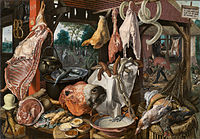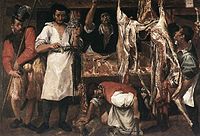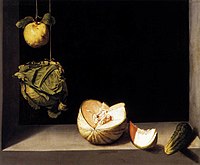
Gradually, religious content diminished in size and placement in this type of painting, though moral lessons continued as sub-contexts. One of the relatively few Italian works in the style, Annibale Carracci’s treatment of the same subject in 1583, Butcher's Shop, begins to remove the moral messages, as did other "kitchen and market" still-life paintings of this period. Vincenzo Campi probably introduced the Antwerp style to Italy in the 1570s. The tradition continued into the next century, with several works by Rubens, who mostly sub-contracted the still-life and animal elements to specialist masters such as Frans Snyders and his pupil Jan Fyt. By the second half of the 16th century, the autonomous still life evolved.
The 16th century witnessed an explosion of interest in the natural world and the creation of lavish botanical encyclopædias recording the discoveries of the New World and Asia. It also prompted the beginning of scientific illustration and the classification of specimens. Natural objects began to be appreciated as individual objects of study apart from any religious or mythological associations. The early science of herbal remedies began at this time as well, which was a practical extension of this new knowledge. In addition, wealthy patrons began to underwrite the collection of animal and mineral specimens, creating extensive cabinets of curiosities. These specimens served as models for painters who sought realism and novelty. Shells, insects, exotic fruits and flowers began to be collected and traded, and new plants such as the tulip (imported to Europe from Turkey), were celebrated in still-life paintings.

The horticultural explosion was of widespread interest in Europe and artist capitalized on that to produce thousands of still-life paintings. Some regions and courts had particular interests. The depiction of citrus, for example, was a particular passion of the Medici court in Florence, Italy. This great diffusion of natural specimens and the burgeoning interest in natural illustration throughout Europe, resulted in the nearly simultaneous creation of modern still-life paintings around 1600.
At the turn of the century the Spanish painter Juan Sánchez Cotán pioneered the Spanish still life with austerely tranquil paintings of vegetables, before entering a monastery in his forties in 1603, after which he painted religious subjects.

Pieter Aertsen, A Meat Stall with the Holy Family Giving Alms (1551), 123.3 × 150 cm (48.5 × 59″)
| 
Annibale Carracci (1560–1609), Butcher's Shop (1580)
| 
Juan Sánchez Cotán (1560–1627), Still life with Quince, Cabbage, Melon and Cucumber, oil on canvas, 69x 84,5 cm
| 
Giovanni Ambrogio Figino, Metal Plate with Peaches and Vine Leaves(1591–94), panel, 21 x 30 cm, his only known still life
|
|---|
With origins in the Middle Ages and Ancient Greco-Roman art, still-life painting emerged as a distinct genre and professional specialization in Western painting by the late 16th century, and has remained significant since then. A still-life form gives the artist more freedom in the arrangement of elements within a composition than do paintings of other types of subjects such as landscape or portraiture. Still life, as a particular genre, began with Netherlandish painting of the 16th and 17th centuries, and the English term still life derives from the Dutch word stilleven. Early still-life paintings, particularly before 1700, often contained religious and allegorical symbolism relating to the objects depicted. Some modern still-life work breaks the two-dimensional barrier and employs three-dimensional mixed media, and uses found objects, photography, computer graphics, as well as video and sound.
The term includes the painting of dead animals, especially game. Live ones are considered animal art, although in practice they were often painted from dead models. The still-life category also shares commonalities with zoological and especially botanical illustration, where there has been considerable overlap among artists. Generally a still life includes a fully depicted background, and puts aesthetic rather than illustrative concerns as primary.
Still life occupied the lowest rung of the hierarchy of genres, but has been extremely popular with buyers. As well as the independent still-life subject, still-life painting encompasses other types of painting with prominent still-life elements, usually symbolic, and "images that rely on a multitude of still-life elements ostensibly to reproduce a 'slice of life'". The trompe-l'œil painting, which intends to deceive the viewer into thinking the scene is real, is a specialized type of still life, usually showing inanimate and relatively flat objects.
Source From Wikipedia
没有评论:
发表评论